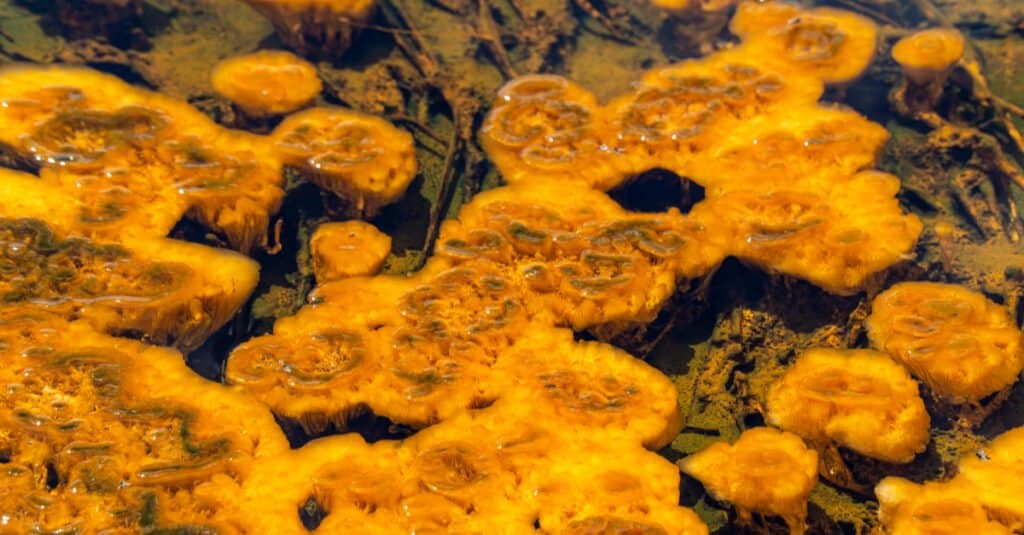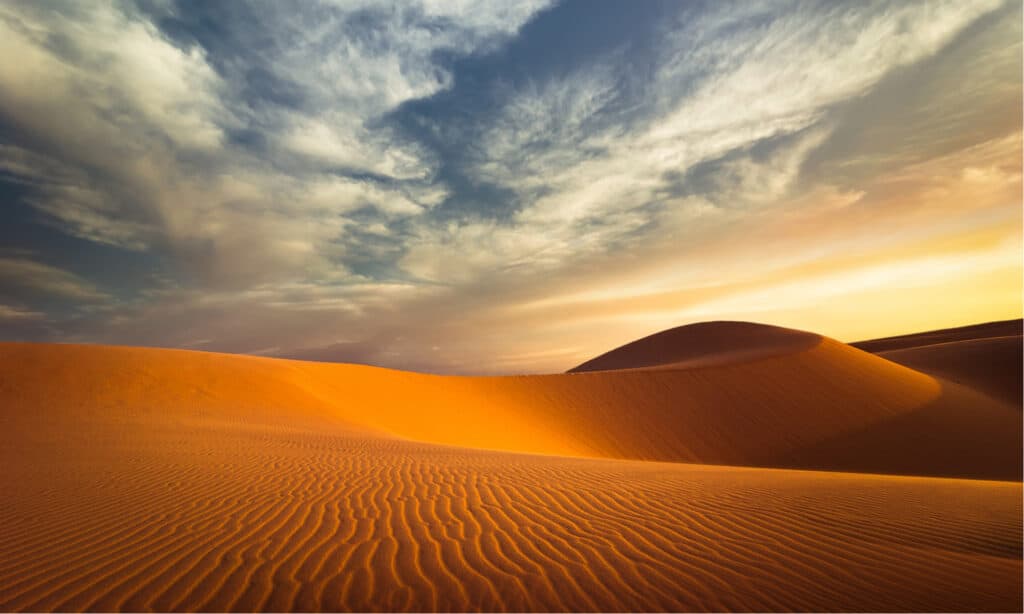You’ve probably seen Venus and didn’t even realize it. It’s often low in the evening sky, the first and brightest star you’ll see at night, the “Evening Star.” Or if you’re an early riser, you may have seen a dazzlingly bright “Morning Star.” Either of these was probably Venus, the third brightest object in our sky after the Sun and Moon. Seen from Earth, Venus looks serene and beautiful, suitable for a planet named after a goddess of love. But we now know appearances are deceiving, because Venus is actually a hellscape of 867 °F that melts lead like butter. Could water exist on such a hot planet? What is Venus made of, and why is it so hot? Could we “fix it” and live there one day? Continue reading for the answers to these questions and more!

Venus can often be spotted around sunrise or sunset. It is the brightest “star” in the sky. The only brighter objects are the Sun and Moon.
©True Touch Lifestyle/Shutterstock.com

Venus usually has a hazy appearance but in this image, the atmosphere has been stripped away to showcase the surface features.
©bluecrayola/Shutterstock.com
What is Venus Made Of?
A Rocky Planet
Venus is the second planet from the Sun. The reason we see it in the mornings and evenings is that it orbits closer to the Sun than we do. It is only a little smaller than Earth and gravity is about 91% as strong as on Earth. So you’d weigh about 9% less there. Astronomers believe the interior of Venus is similar to Earth as well, with a core, a mantle, and a crust. Volcanoes on the planet have erupted so extensively, 80% of the surface is covered with smooth plains. It has a highland “continent” in the northern hemisphere about the size of Australia and one in the southern hemisphere about the size of South America. Venus does not appear to have plate tectonics, maybe because the crust is too strong, and this traps heat inside the planet.

Extensive volcanic eruptions on Venus resurfaced 80% of the planet and released greenhouse gases into the atmosphere.
©Michail_Vorobyev/Shutterstock.com
A Crushing Atmosphere
The atmosphere of Venus is 96.5% carbon dioxide, with nitrogen taking up the other 3.5%. Carbon dioxide is a greenhouse gas that allows heat from the sun to penetrate but not escape efficiently, so the surface temperature has reached 867 °F. The atmospheric pressure at the surface is about 92% higher than that of the Earth’s surface. At this temperature and pressure, the atmosphere reaches a supercritical state, which means that there is no longer a distinction between a gaseous state and a liquid state. Venus also has sulfuric acid clouds in its atmosphere that have likely resulted from extensive volcanic eruptions.
Does Venus Have Water?
No. Venus has been described as a “bone dry” planet. Because it is so close in size to Earth it could be our twin, many scientists do believe that Venus likely had oceans of water in the past as our planet does today. But over time it lost 99.9% of its water for unknown reasons. It’s closer to the Sun than we are, so it already started out hotter. Volcanic eruptions could have released large amounts of carbon dioxide into the atmosphere, getting a greenhouse effect started. As the oceans evaporated in the heat, sunlight broke up the water molecules, releasing hydrogen that drifted off into space and was taken away by the solar wind, while the oxygen remained behind. Whatever the mechanism, Venus today is devoid of water.

Any oceans on Venus long ago boiled away from the intense heat of the Sun and the planet’s greenhouse effect.
©buradaki/Shutterstock.com
Life on Venus?
Incredibly, despite the nightmarish conditions on Venus, some scientists suggest there may be conditions suitable for life high in the planet’s atmosphere. For example, at about 30 miles above the surface, the atmospheric pressure is similar to that of Earth. Atmospheric life there might be something like the bacterial thermophiles on our planet that survive in superheated water and high pressure around undersea volcanic vents or hot springs such as those found in Yellowstone National Park. Yet even these require water, so other researchers assert that life is impossible on Venus because it is too dry. This is assuming, of course, that life there would have evolved in much the same way as life here.

On Earth, thermophiles are lifeforms that thrive at extremely high temperatures, such as those found around geothermal features.
©GeoNtoH/Shutterstock.com
Exploring Venus
Venus was the first planet that humans tried to send a spacecraft to, with the Soviet Union crashing two space probes into it in 1961 before the United States achieved the first successful landing on the surface by an unmanned probe the following year. In all, about 40 missions have been launched to our sister planet, including flybys, orbiters, and landers, but nothing has been able to survive on the surface longer than a couple of hours before being crushed and melted. Currently, Japan has an orbiter above the planet and NASA plans to land a probe on the surface in 2031. Venus is of great interest to scientists because its similarities and proximity to Earth make them think they can learn more about our own planet’s history by studying its twin. They also hope by studying it to gain insights into how to prevent Earth from going down the same path of catastrophic global warming.

Scientists hope that by learning more about Venus they can help humanity prevent and maybe reverse global warming on Earth.
©Perfect Lazybones/Shutterstock.com
Can We Live on Venus?
Living on Venus today is impossible, at least on the surface. The most you could hope for would be to live in an orbiting spacecraft high in or above the planet’s atmosphere. But could we do more than that? Could we terraform Venus one day to make it inhabitable by people? There are just two little problems: lack of a breathable atmosphere and lack of water. Oh, is that all? Yes, clearly those are prohibitive obstacles for our current level of technology, but who’s to say where we will be a century from now, two centuries, or three? Perhaps we will successfully colonize the Moon, Mars, moons of the outer planets, or asteroids. With accumulating experience and new energy sources, advances in genetic engineering, AI, and nanotechnology, would we be able to reduce the carbon in the atmosphere and build up an oxygen atmosphere? Will we one day have the capability of targeting water-rich comets toward Venus with precision to rebuild its oceans? Or would we destroy ourselves in the process of trying to achieve such ambitions? Terraforming Venus is very much in the realm of science fiction, but science fiction has this persistent way over time of becoming science fact.

Terraforming Venus is centuries beyond our current technology, but with the assistance of AI and other emerging technologies, we might in the future take leaps forward that are currently unimaginable.
©Ground Picture/Shutterstock.com
The photo featured at the top of this post is © iStock.com/3quarks
Thank you for reading! Have some feedback for us? Contact the AZ Animals editorial team.







